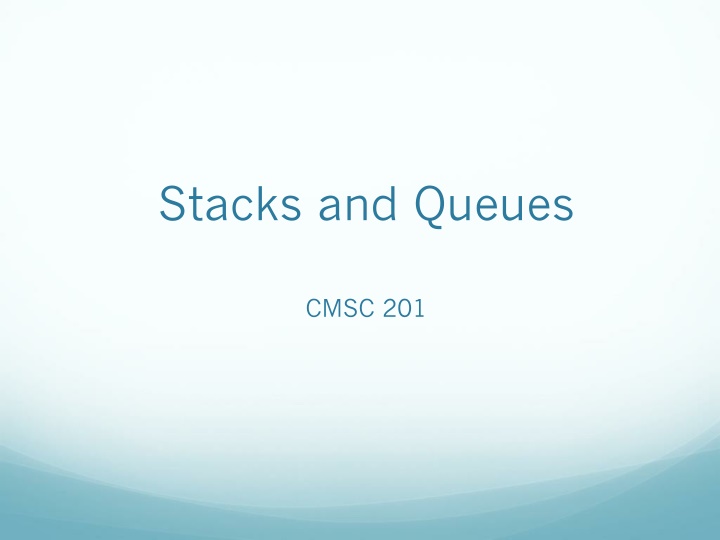
Understanding Stacks and Queues in Data Structures
Explore the concepts of stacks and queues in data structures, distinguishing their unique characteristics and operations. Learn how to implement them using Python and grasp the FIFO and LIFO principles behind queues and stacks respectively.
Download Presentation

Please find below an Image/Link to download the presentation.
The content on the website is provided AS IS for your information and personal use only. It may not be sold, licensed, or shared on other websites without obtaining consent from the author. If you encounter any issues during the download, it is possible that the publisher has removed the file from their server.
You are allowed to download the files provided on this website for personal or commercial use, subject to the condition that they are used lawfully. All files are the property of their respective owners.
The content on the website is provided AS IS for your information and personal use only. It may not be sold, licensed, or shared on other websites without obtaining consent from the author.
E N D
Presentation Transcript
Stacks and Queues CMSC 201
Stacks and Queues Sometimes, when we use a data-structure in a very specific way, we have a special name for it. This is to make it clear how the list is to be used. A lot of languages even provide special kinds of variables for these special cases.
Stacks and Queues What we re going to talk about in the following slides are not always going to be python things. We are going to talk about the idea idea of what a stack and a queue is. The way we actually implement them in python will be included separately.
Queues A queue is a special kind of list where we can only perform the following operations: enqueue(someItem) puts some item at the end of a queue. dequeue() removes and returns the item at the start of the queue. These two operations are what makes something a queue!
Queues What this means: The result of only having these two operations is that the whatever you remove is always the thing that s been in the queue longest! Imagine a queue like a line at the grocery store whoever has been in line the longest gets to go first. enqueue() is like someone new getting line. dequeue() is the person at the front of the line checking out. Queues are referred to as First in first out, or FIFO .
Queues In Python How to use a python list as a queue: In python, we don t have functions named enqueue and dequeue. Instead, we have insert(0, myItem), which adds something to the beginning of the list, and a function called pop(), which removes and returns the endof the list. If these are the only two things we are using to modify the list, it s a queue!
Stacks A stack supports two operations: push(someItem) puts something at the end of the stack. pop() returns the item at the end of the stack.
Stacks Having only these two functions gives us a behavior where whenever we remove something, it s the thing we put on the stack most recently. most recently. Imagine a stack of plates. push() is analogous to putting a plate on the top of the stack, pop() is like taking that plate back off. Stacks are referred to as Last in first out , or LIFO .
Stacks in Python If we want to simulate a stack in python, we can use append() to add something to the stack, and pop() to remove something. pop() will always return exactly what append just added.
